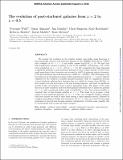Files in this item
The evolution of post-starburst galaxies from z=2 to 0.5
Item metadata
| dc.contributor.author | Wild, Vivienne | |
| dc.contributor.author | Almaini, Omar | |
| dc.contributor.author | Dunlop, Jim | |
| dc.contributor.author | Simpson, Chris | |
| dc.contributor.author | Rowlands, Kate | |
| dc.contributor.author | Bowler, Rebecca | |
| dc.contributor.author | Maltby, David | |
| dc.contributor.author | McLure, Ross | |
| dc.date.accessioned | 2016-08-12T08:30:33Z | |
| dc.date.available | 2016-08-12T08:30:33Z | |
| dc.date.issued | 2016-11-21 | |
| dc.identifier | 244954023 | |
| dc.identifier | e942f628-76bc-4b1e-bbc1-caba766844af | |
| dc.identifier | 000386464900068 | |
| dc.identifier | 84996583940 | |
| dc.identifier.citation | Wild , V , Almaini , O , Dunlop , J , Simpson , C , Rowlands , K , Bowler , R , Maltby , D & McLure , R 2016 , ' The evolution of post-starburst galaxies from z=2 to 0.5 ' , Monthly Notices of the Royal Astronomical Society , vol. 463 , no. 1 , pp. 832-844 . https://doi.org/10.1093/mnras/stw1996 | en |
| dc.identifier.issn | 0035-8711 | |
| dc.identifier.other | BibCode: 2016arXiv160800588W | |
| dc.identifier.other | BibCode: 2016MNRAS.463..832W | |
| dc.identifier.uri | https://hdl.handle.net/10023/9291 | |
| dc.description | V. W. and K. R. acknowledge support of the European Research Council via the award of a starting grant (SEDMorph; P.I. V. Wild). | en |
| dc.description.abstract | We present the evolution in the number density and stellar mass functions of photometrically selected post-starburst galaxies in the UKIDSS Ultra Deep Survey, with redshifts of 0.5 < z < 2 and stellar masses log (M/M⊙) >10. We find that this transitionary species of galaxy is rare at all redshifts, contributing ∼5 per cent of the total population at z ∼ 2, to <1 per cent by z ∼ 0.5. By comparing the mass functions of quiescent galaxies to post-starburst galaxies at three cosmic epochs, we show that rapid quenching of star formation can account for 100 per cent of quiescent galaxy formation, if the post-starburst spectral features are visible for ∼250 Myr. The flattening of the low-mass end of the quiescent galaxy stellar mass function seen at z ∼ 1 can be entirely explained by the addition of rapidly quenched galaxies. Only if a significant fraction of post-starburst galaxies have features that are visible for longer than 250 Myr, or they acquire new gas and return to the star-forming sequence, can there be significant growth of the red sequence from a slower quenching route. The shape of the mass function of these transitory post-starburst galaxies resembles that of quiescent galaxies at z ∼ 2, with a preferred stellar mass of log (M/M⊙) ∼10.6, but evolves steadily to resemble that of star-forming galaxies at z < 1. This leads us to propose a dual origin for post-starburst galaxies: (1) at z ≳ 2 they are exclusively massive galaxies that have formed the bulk of their stars during a rapid assembly period, followed by complete quenching of further star formation; (2) at z ≲ 1 they are caused by the rapid quenching of gas-rich star-forming galaxies, independent of stellar mass, possibly due to environment and/or gas-rich major mergers. | |
| dc.format.extent | 13 | |
| dc.format.extent | 2032149 | |
| dc.format.extent | 2047189 | |
| dc.language.iso | eng | |
| dc.relation.ispartof | Monthly Notices of the Royal Astronomical Society | en |
| dc.subject | Galaxies: high-redshift | en |
| dc.subject | Galaxies: luminosity function, mass function | en |
| dc.subject | Galaxies: formation | en |
| dc.subject | Galaxies: evolution | en |
| dc.subject | Galaxies: stellar content | en |
| dc.subject | QB Astronomy | en |
| dc.subject | QC Physics | en |
| dc.subject | NDAS | en |
| dc.subject | BDC | en |
| dc.subject.lcc | QB | en |
| dc.subject.lcc | QC | en |
| dc.title | The evolution of post-starburst galaxies from z=2 to 0.5 | en |
| dc.type | Journal article | en |
| dc.contributor.sponsor | European Research Council | en |
| dc.contributor.institution | University of St Andrews. School of Physics and Astronomy | en |
| dc.identifier.doi | https://doi.org/10.1093/mnras/stw1996 | |
| dc.description.status | Peer reviewed | en |
| dc.identifier.url | http://adsabs.harvard.edu/abs/2016arXiv160800588W | en |
| dc.identifier.grantnumber | ERC-2012-StG-20111012 | en |
This item appears in the following Collection(s)
Items in the St Andrews Research Repository are protected by copyright, with all rights reserved, unless otherwise indicated.

